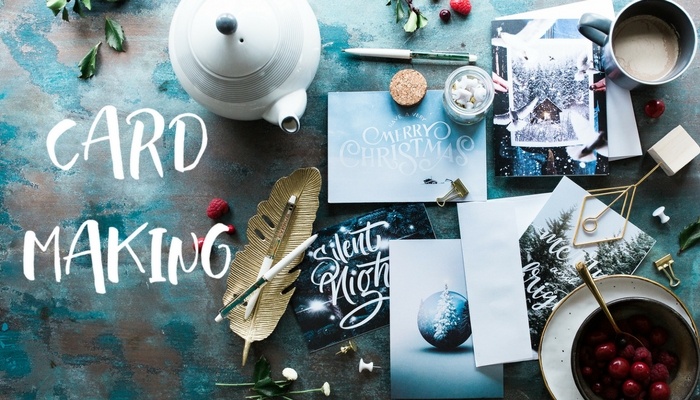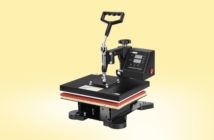Is there anything more personal and meaningful than card making?
Greeting cards are such an important part of our culture. They help us to express our thoughts and sentiment to those we care about.
There are cards for literally any occasion you can think of: wishing someone a Happy Birthday, for a partner on Valentine’s Day, or congratulating a colleague on their promotion… the list is endless.
You’re bound to find a card that suits every occasion. But with all these events, you can end up spending quite a lot of time and money choosing and buying the right card
And that’s why card making has become one of the most popular paper crafts in the USA today.
Here’s our complete guide to everything to do with making your own cards, including how to do it, the supplies you need and the different techniques you can learn.
Contents
Benefits of Card Making
Among the greatest benefits of making your own cards is how cheap it is, especially when compared to prices of ready-made cards. Supplies are generally cheap and easily found.
Card making is not only a cheaper option, but a far more thoughtful one.
After all, it’s great to know that someone spent their time and energy hand-making and personalizing something especially for you.
Card making is also one of the most versatile crafts: there are several techniques, tools, and materials you can use to produce your very own, very unique creations.
We’ve found that it allows us a huge amount of creative freedom — despite the fact that it’s such a cheap and quick hobby.
Card Making Supplies
First things first, you need to make sure you have all the right materials before you get started.
While you could get away with using craft basics such as a pair of scissors, construction paper, and PVA glue – a few basic paper crafting tools can really take your cards to the next level.
By investing in some of these card making supplies, you’ll be creating hassle-free professional cards in no time at all.
Card Stock
To create your own cards, you definitely need card!
To start with, it’s best to stock up on 8.5″ x 11″ smooth, white card. Cutting one of these pages in half and folding it makes the perfect sized card.
If you want to save yourself time cutting and folding, you can find pre-cut and pre-folded cards in craft stores — but you may be limited to colors and sizes.
Smooth cardstock is great for card making, as you can easily write your message on the inside. However, textured cardstock is great for decorating and embellishing.
It may be worth buying both initially to find out which one you prefer to work with.
Patterned Paper
Patterned paper is very useful for card making, and can help serve as embellishments and texture on the base cardstock.
It’s best to purchase a paper collection so you’ve got access to the widest array of different patterns. It’s also much more economical than to buy the paper in individual stacks.
There are thousands of beautiful paper collections available, and most include coordinating embellishments and stickers.
Paper Trimmer
A paper trimmer is extremely useful when it comes to card making. They guarantee straight and square edges, and they make cutting so much easier and faster.
Most paper trimmers have a trimming tool (for cutting paper) and a scoring tool (for creasing paper).
You can either buy a larger guillotine style trimmer, which is particularly good for trimming multiple sheets — and probably the best for people running small card making businesses — or a craft size one. These are generally smaller, cheaper and more portable, but can’t handle the same quantity of sheets as a guillotine.
Decorative Embellishments
You can find a wide range of decorative embellishments in many craft stores.
It is always best to have a good variety of embellishments to start with, so you can discover what works well together and what you like to work with.
Embellishments are a great way to decorate and personalize your creations. For us, choosing and applying the embellishments is the most fun part of card making!
Adhesive Runner
When attaching photos and paper to cards, you want something that is lightweight but strong enough to hold the materials together.
For this, you’ll find that an adhesive runner does the trick.
Adhesive Dots
Foam adhesive dots are great for emphasizing embellishments — they elevate elements off the page, adding an extra dimension to the card.
Put them behind a bow or a flower and watch how your card springs to life! Adhesive dots are a great alternative to a glue gun.
Most card making tools can be found in craft stores and you can find a wide range available online at even cheaper prices.
How to Make a Card
Now you have all the materials you need, you can get started with card making for real.
Here’s a step by step guide on how to make your own cards…
Creating the Base Card
The piece of cardstock folded in half is called the ‘base card’, and it’s the foundation for which you can add all your embellishments and decorations to.
You need to score your card stock first. Scoring a piece of card stock means to create an indention on your card against a ruler. If you don’t have a paper trimmer that can score for you, you can use a blunt knife, an old pen, or the back of a pair of scissors instead,
Scoring the card makes it easier to fold and avoids any ragged edges on the sides. If you have a paper trimmer, then you can use the scoring tool for this step.
Once you have your score line in your card stock, your paper is ready to be folded. You need to fold on the bump of your score line — so once you finished scoring your paper in the middle, turn the paper over and fold it.
And that’s your base card!
Decorating the Base Card
Now that we have a base card, we can start adding embellishments, papers, and a sentiment. This part is the most fun and you can decide how you would like to decorate your card.
Here are a few ideas for decoration:
You could add a background paper, leaving a white edge as a subtle frame around the card. You can also cover the whole of the card front with a patterned paper.
You may find that by keeping your designs simple, your cards will look much more professional. You could also add some ribbon across the card either vertically or horizontally to finish your card.
If you are struggling for ideas, the internet is a great place for inspiration. You can search various card designs and find out which ones you like best.
Once you have finished decorating your card, make sure you leave enough time for it to dry before placing it in the envelope. It’s probably best to buy pre-made envelopes from a craft store.
How to Make a Pop-Up Card
We’ll be looking at different card making techniques in a moment, but we thought it was worth covering in detail one particular technique first: how to make a pop-up card.
This are probably the most popular type of home made card, and certainly one of the most fun and dramatic to make.
Here’s a step by step guide:
- Create your base card as detailed above
- Make two inch-long parallel cuts across the folded edge of the card — this creates the pop-up! A larger distance between the two cuts creates a larger pop-up, so measure it according to your design
- Crease the pop-up on both sides, open the card and pull the pop-up up towards you
- Glue your image to the pop-up
- Fold the card back together
- When you open it up again, the pop-ups should jump out at you!
Here’s a good video showing you how if you need some visual assistance:
Different Card Making Techniques
There are several techniques to making quality cards – some are more complicated than others, but you’ll be able to find many techniques that suit you.
Remember to keep trying and experimenting with new things!
It would be impossible to go into detail on every technique out there, but we have a list of the ones you may find most fun and useful.
Remember, techniques become easier with practice and you may find yourself developing your own techniques with the more cards you make. Here are a few you might want to try:
Quilling
Quilling is the craft of creating delicate shapes from strips of paper.
This can be a great technique if you want to create and add your own embellishments to your cards. Quilling can also be a great way to create decorative borders around your cards.
This particular technique requires a steady hand, but once you get going, it’s really simple and effective.
Personally, we find that quilling is a great way to get rid of all our scrap paper that we no longer need. A beautiful version of recycling!
Embossing
Embossing creates a raised image on the paper — and is a great way to showcase different textures. This is one of the most common techniques in card making as it’s a simple and great way to decorate cards.
This technique is simple but you need to ensure you have the right materials. You will need special embossing powder and stamps – which are readily available in many craft stores.
Or you can use a die cutting machine…
Die Cutting
We covered all the ins and outs of die cutting in another post (which you can read here) but it’s fair to say that this is a very common technique for creating embellishments and different textures for card making.
The best and easiest way to produce die cuts is to use a specialist machine, which can be bought reasonably cheaply online.
The most popular are probably the Sizzix Big Shot:
Which can cut and emboss a range of different materials and patterns…
And the Cricut Explore Air 2:
Which can cut over 100 different materials of any design that you create using their specialist software. You can read an indepth review of the machine here.
Block Printing
A block print is an ink impression of a design carved into wood, linoleum, or other engravable material.
Once you’ve cut out a design, you can use the block to make an unlimited number of identical prints. This works well with vintage inspired designs and looks great when creating simple greeting cards.
![]()
Rubber Stamps for Card Making
Stamping is another way to make your cards look wonderfully professional — plus it’s an easy way to speed up the card making process!
You can use the stamps on the front of the card for the sentiment, or even inside if that suits you. You can also buy beautiful image stamps — great if you want to save time or aren’t confident in your drawing abilities.
Here are some of our favorite rubber stamps for card making:
Card Making Ideas
There are many card making ideas and designs, and the possibilities are boundless when creating your own cards.
If you are struggling for inspiration, here are a few simple card making ideas to help you get started:
Solid Variation
As we mentioned earlier, keeping decoration simple is probably the best when creating your own cards. It’s very easy to get carried away when decorating and end up creating a cluttered, over-done card.
This idea will help you to keep decoration as simple and elegant as possible.
Use three or four shades of one color of ink with various sizes of solid, silhouette images. Make sure the image is a simple one – this could be an outline of an object or animal.
The sentiment should stand out boldly against the silhouettes and the rounded corners will add interest while softening the overall appearance.
Center Stage
Choose an image that requires little coloring and stamp it onto the center of a white cardstock block.
Cover a white card base with patterned paper then add coordinating bits of color to the stamped image. This is another simple but effective way of decorating your card. Under the image you can add your own greeting or message.
Patterned Paper Designs
Use a block of patterned paper to draw the eye to a simple embellishment or sentiment.
A pre-fab flower and rub-on sentiment could be used to create this card in minutes – this design is simple and cost effective, as you don’t require many materials for this design.
Chipboard Stickers
To create a card in minutes, place a chipboard sticker over patterned paper and card base.
To “deactivate” the sticky back hanging off the side of the card, apply powder or stick repeatedly to a light-colored fabric until it is no longer sticky.
Take a look at our Pinterest board for hundreds more card making ideas:
To Wrap Up
Once you have mastered your card making skills and are comfortable and confident in your crafting abilities – why not try a card making business?
In our opinion, it’s one of the cheapest and easiest crafts to get started in and just requires a little time and investment to get really good at it.
Happy card making!







